Justin Sexten: Remote Control Grazing Management

Farming and ranching simulators can be found on the digital devices of kids and adults across the country. Some suggest these games have led to a consumer's view that food pops out of the ground and can be harvested with a swipe of the finger. Coupled with the row and vegetable crop technology showcased on social media one can easily imagine a digital farm.
Cropping systems are relatively uniform in management with straight rows, singular crops and similar management applied across the field. This consistency is often cited as the reason cropping systems are more digitized than livestock. The plant’s inability to move makes for simpler system design, note simpler not necessarily easy.
Precision farming is often focused on offering solutions to variable soil and plant conditions or minimizing labor needs. Two recent articles highlight technology advances graziers may someday implement to digitize pasture management addressing variable pasture conditions and labor needed to manage them.
Adrien Michez and Belgium co-workers reported pasture monitoring results in the Remote Sensing journal where they used several drones to quantify forage availability and quality of pastures. Forage researchers are always interested in both forage quality and quantity whereas producers tend to have different focuses depending on animal performance goals.
For grazing dairy and pasture finishing systems quality is key. In most beef cattle grazing systems the amount of forage drives stocking and grazing management decisions long before quality becomes an issue. High quality forage is of little value if there isn’t enough grass to graze, regardless the system, so the ability to quantify grazable forage is a key metric of the technology.
The drones were flown over the test pastures at solar noon to minimize the effects of shadows and the pastures were a single species, timothy, to minimize prediction variation. To implement the technology we would agree the prediction models would need to evolve to evaluate multiple forage pastures and allow for morning and evening flyovers to combine pasture and cattle checking.
The drones used in this test were off-the-shelf models fitted with common sensing equipment to demonstrate the ability to use readily available and cost effective technology. The test was successful at predicting forage height, biomass and various measures of quality. Forage availability predictions were better than some more refined manual methods such as a rising-plate meter.
Another interesting grazing focused article was a virtual fencing report from Animals by Dana Campbell and Australian co-workers who tested the eShepherd® virtual fence’s ability to create exclusion areas to prevent grazing of an environmentally sensitive area. The concepts outlined in this report combined with the drone experiment highlights how we can integrate technology advancements to develop actionable data-driven grazing management plans.
This electronic fencing test was implemented over a 44 day grazing period in a 34.5 acre pasture. The exclusion zone was changed slightly over time to train the animals and had an irregular boundary. The irregular boundary is significant as cattle were forced to respond to the audio cues rather than respond to a site line of exclusion. The ability to implement irregular boundaries will be key to commercial adoption of virtual fencing.
During the grazing period forage availability within the included pasture declined while the exclusion increased, suggesting the grass was greener across the virtual boundary. The cattle proved this by continually encountering the virtual fence.
Despite this increased forage availability, cattle remained outside the exclusion 99.8% of the grazing period. Additionally the cattle received a greater number of audio warnings than electrical corrections. These results suggest the cattle were responding to the cues when they did enter the exclusion area.
There were a couple animals that persisted in entering the excluded area despite the cues. I suspect regardless of the fencing type many of you will agree there is always “the one” who finds the weak link in the fencing system.
These experiments offer us a look into the future of ranch management technologies. A way to remotely monitor pasture conditions, set up exclusion areas based on forage quantity and quality and deploy a virtual fence while setting at the pasture gate. For many, automated pasture allocations may not be in your immediate future, but the technology is advancing.
Today grazing management is limited to permanent fences, our ability to set up temporary paddocks and moving animals when we can. Imagine the day where we set up a weekly pasture flyover, weather data are integrated, waterers are waypoints and stocking rates are adjusted by virtual fencing. What we consider a simulation today could be tomorrow's routine management.
Related stories:







